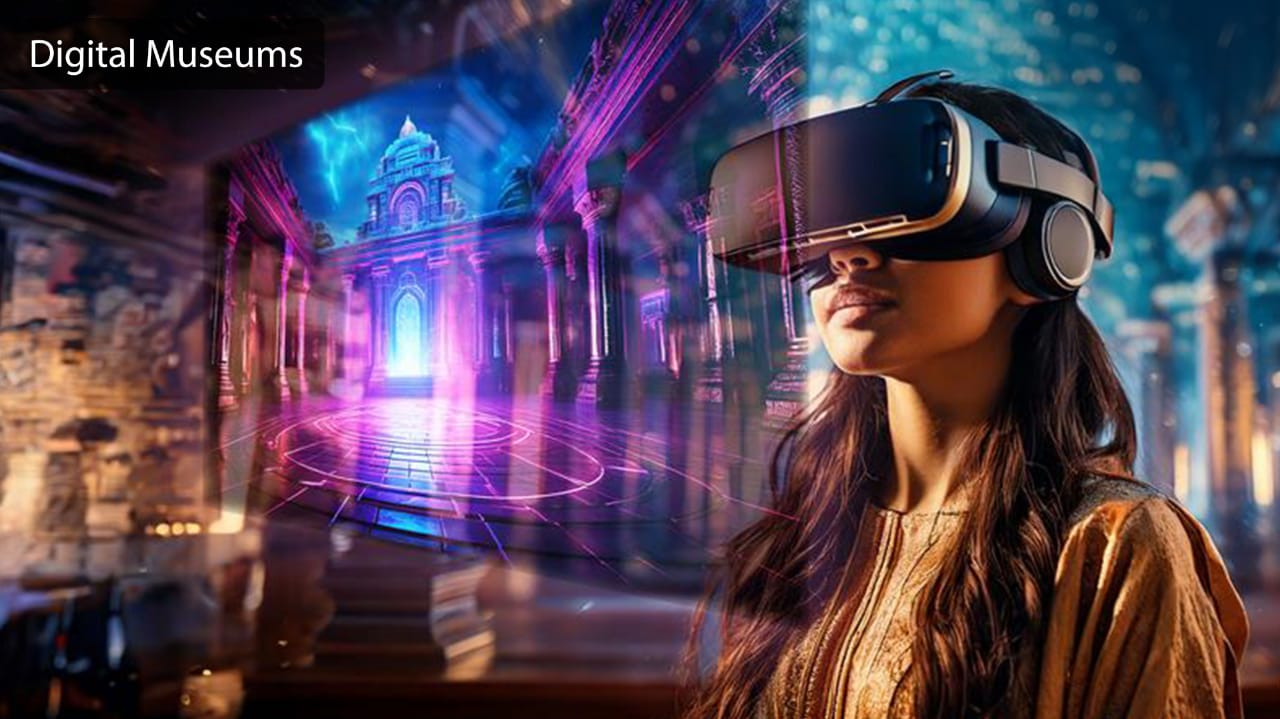The latest technological advancements have transformed digital museums into completely dynamic environments that enable accessibility and visitor involvement. AI personalization, digitally engaged sustainability, immersive and interactive experiences, and digital preservation are expected to be the top trends in 2025. Let’s examine these trends in more detail:
1. Immersive and Interactive Experiences
VR and AR
Museums are presenting their treasures in a different way by using virtual reality (VR) and augmented reality (AR). They allow visitors to:
-
Discover them online, enabling in-person viewing with museums that care for them.
-
Learn about the history and value of artifacts by virtually interacting with them.
-
Project digital content over real-world ones to use dynamic storytelling and create a captivating narrative.
Interactive Displays
In order to further improve visitor engagement, AR VR museums are now incorporating even more cutting-edge technologies into their operations:
-
Touchscreens: For gaining access to multimedia contents, such as timelines, films, and high-quality pictures for deeper exploration.
-
Motion sensors: Making it possible for interactive displays to react to movement, offering a gamified and engaging experience.
-
Haptic Feedback Systems: Allow users to engage with virtual things in real life, creating a rich multi-sensory experience.
Hybrid Experiences
Combining digital overlays with tangible artifacts is known as hybrid, and it allows for the following:
-
Allow visitors to explore the site’s digitally recreated ancient ruins.
-
Project 3D models and animations onto real-world objects to enable real-time interactions.
-
Integrate immersive digital narratives with traditional displays’ improved storytelling techniques.
2. AI and Personalization
AI-Powered Tours
A new museum experience is being shaped by AI. AI-powered instruments could:
-
Create tours based on the visitor’s age, preferences, and available time.
-
Offer multilingual audio guides that take cultural factors into account.
-
Allow itineraries to be adjusted in real time according to visitor engagement measurements.
Personalized Recommendations
The AI-powered systems examine visitor behavior and preferences to:
-
Depending on their interests, suggest activities and exhibits.
-
By keeping track of the visitor’s past and tailoring subsequent experiences accordingly, you may promote return visits.
-
By dynamically changing the content a visitor accesses during their visit, you may promote greater engagement.
3. Digital Engagement and Accessibility
Mobile Apps and Guided Tours
The advanced mobile applications developed by modern museums are:
-
Using interactive maps to help with navigating
-
Multimedia contents, such as behind-the-scenes videos featuring interviews with curators
-
Assisting museum visitors with self-guided tours to give them greater autonomy to explore the space.
Digital Accessibility
Museums are adopting the following actions to have all types of visitors:
-
Creating content that people with disabilities can understand, like sign languages, audio descriptions, and subtitles.
-
Involving assistive technology, including screen readers and voice-activated navigation.
-
Allowing anyone who is unable to visit the museum for whatever reason to take virtual tours.
4. Community Engagement
Community Hubs
Museums are embracing vibrant spaces for all communities:
-
Keeping an eye on cultural events, themed art workshops, and educational initiatives.
-
Promoting local involvement in exhibit co-curation.
-
Establishing forums for discussion of environmental, social, and cultural issues.
5. Digital Preservation and Digitization
Digital Twins
Virtual copies of artifacts and locations, known as digital twins, are making it possible to:
-
Protection of cultural heritage from natural calamities or physical degradation.
-
Online platforms provide access to collections worldwide.
-
High-resolution images and features allow for interactive exploration of museum artifacts.
3D Scanning and Printing
Modern technology such as 3D printing and scanning are enabling museums to:
-
Preserving the original artifact while making replicas for display or education
-
Providing enough information about artifacts to make them useful files for study and preservation
-
Provide instructive programs where visitors can interact with replicas.
6. Cloud-Based Ticketing
In the manner in which visitors have fun:
-
Utilizing environmentally friendly paperless ticketing systems.
-
Contactless entry, which guarantees ease and safety.
-
Timed entrances that maintain visitor comfort while managing crowd movement.
Conclusion
The digital revolution of museums in 2025 is bringing about a completely new situation in terms of art, history, and culture. These museums have historically improved the experience of their visitors by offering a wide range of technology, such as VR, AR, AI, and 3-D printing. It is reasonable to argue that contemporary museums have not fully outlined a new future because these developments are closely related to accessibility, sustainability, and the preservation of cultural heritage. Rather, they have developed dynamic areas that combine aspects of the past, present, and future, and their integration for community and education extends beyond the physical environment.
